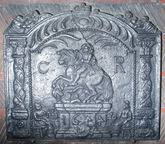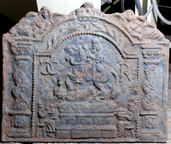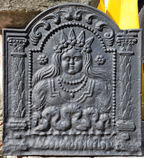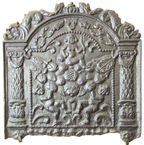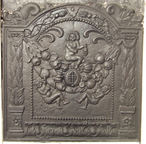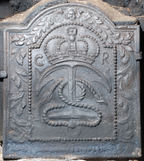-
280
Description: Arched rectangular shaped central panel, bead edging (top and sides), pedestal bearing a supine male figure with headband being trampled by a horse, facing left, mounted by a rider with long hair, facing to the front; on each side of the plinth is a seated figure wearing a hat, with a basket of fruit; above the rider are crescent lines representative of clouds; the inscription is split either side of the horse; the date (‘7’ rotated and, with ‘4’, reversed) is on the die of the pedestal; arched rectangular shaped border, fillet edging, on each side a Solomonic column with vine decoration; in the arch, symmetrical parallel curved lines with a central oval cartouche beneath a crown; on top of each shoulder of the plate a figure in repose.
Notes: The equestrian figure is derived from the statue of Charles II erected in Stocks Market, London, in 1672. Originally to be of Jan Sobieski, later king of Poland, riding down a Tatar, it was altered to represent Charles, and the Tatar’s face was changed to that of Oliver Cromwell; the statue attracted a fair degree of derision. The statue is now at Newby Hall, near Ripon, North Yorkshire. Another version (no. 464) omits a date and has altered initials.
Copies of this fireback are known.
Inscription: C R / 1674
- Decoration tags:
- 'Dutch' (shape)
- cavetto (edging)
- whole carved pattern
- individual numbers
- pictorial
- historical
- architectural
- text
- animals
- humans
Manufactured: in 1674 in England.
Current location: Chequers, Ellesborough, Buckinghamshire, England.
Citation: Lloyd, N., 1925, 'Domestic Ironwork I', Architectural Review, 58, pp. 58-67.
- Attached to series:
- Carolean 'Dutch' series
- Commemorative firebacks
-
282
Description: Arched rectangle; cavetto moulded edging; garter enclosing Stuart royal arms, crown, crowned lion and unicorn supporters and motto; initials in top corners.
Notes: The crown is not typically English in form, suggesting that the patternmaker may have been of foreign extraction.
Copies of this fireback are known.
Inscription: C R / [Garter motto - illeg.]
Arms: English Stuart royal
- Decoration tags:
- arched rectangular (shape)
- cavetto (edging)
- whole carved pattern
- armorial
- royal
- text
Manufactured: in the mid to late 17th century in England.
Current location: Chequers, Ellesborough, Buckinghamshire, England.
-
464
Description: Arched rectangular shaped central panel, bead edging (top and sides), pedestal bearing a supine male figure with headband being trampled by a horse, facing left, mounted by a rider with long hair, facing to the front; on each side of the plinth is a seated figure with a basket of fruit; the inscription is split either side of the horse; arched rectangular shaped border, fillet edging, on each side a Solomonic column with vine decoration; in the arch, symmetrical parallel curved lines intertwined beneath a crown; on top of each shoulder of the plate a female figure in repose.
Notes: The equestrian figure is derived from the statue of Charles II erected in Stocks Market, London, in 1672. Originally to be of Jan Sobieski, later king of Poland, riding down a Tatar, it was altered to represent Charles, and the Tatar’s face was changed to that of Oliver Cromwell; the statue attracted a fair degree of derision. The 'CC' monogram is likely to be for Charles and Catherine (of Braganza). The statue is now at Newby Hall, near Ripon, North Yorkshire. Another version (no. 280) is dated 1674 and has altered initials.
Copies of this fireback are known.
Inscription: CC [interlocked, and the first reversed] R
- Decoration tags:
- 'Dutch' (shape)
- ovolo (edging)
- whole carved pattern
- individual letters
- pictorial
- historical
- text
Manufactured: in the mid to late 17th century in England.
Current location: in private hands, Little Horsted, East Sussex, England.
- Attached to series:
- Carolean 'Dutch' series
- Commemorative firebacks
-
477
Description: Arched rectangular shaped central panel, bead edging, bust of female figure with long hair and eastern crown decorated with flowers; arched rectangular shaped border with fillet edging; leafed, Corinthian column on each side with symmetrical swirls of foliage above and a row of acanthus leaves below.
Notes: The figure is that of the Virgin, part of the arms and crest of the Mercers’ Company: Issuant from a Bank of clouds a Figure of the Virgin couped at the shoulders proper, vested in a crimson robe adorned with gold, the neck encircled by a jewelled necklace, crined Or and wreathed about the temples with a chaplet of Roses alternately Argent and of the first, and crowned with a Celestial Crown. The arms were first recorded in 1568. One of a small series of firebacks with similar proportions and detail.
Copies of this fireback are known.
- Decoration tags:
- quasi-arched rectangular (shape)
- cavetto (edging)
- whole carved pattern
- pictorial
- allegorical
- humans
Manufactured: in the mid to late 17th century in England.
Current location: Maidstone Museum, St Faith's Street, Maidstone, Kent, England.
(part of the Maidstone Museum museum group)
- Attached to series:
- Carolean 'Dutch' series
- Livery company firebacks
-
575
Description: Arched rectangular shape; cavetto-moulded edging; on each side a column of small overlapping leaves above a pedestal with a single acanthus leaf; issuing from the top of each column two ribbons, in figure-of-eight with grenade terminals, fly across the arch; within an arched rectangular central panel with bead edging three naked children disport about a swag of fruit, with a central pomegranate, suspended from the top of each column; one figure sits on the top, facing right, the other two hang symmetrically from below, with mirrored swirls behind them; along the base is a line of acanthus leaves; on top a sea serpent is curled on each end.
Notes: The design may have been inspired by the paintings of Jan Pauwel Gillemans the younger (1651-1704); he may have worked in London in 1675-8. Another version of the fireback (no. 591), probably by the same pattern-maker, has a slightly different design.
Copies of this fireback are known.
- Decoration tags:
- 'Dutch' (shape)
- cavetto (edging)
- whole carved pattern
- planklines
- pictorial
- mythological
- humans
- plants
Manufactured: in the late 17th century in England.
Current location: Petworth House, Petworth, West Sussex, England.
Museum number: PET/M/66 (part of the National Trust museum group)
- Attached to series:
- Carolean 'Dutch' series
-
591
Description: Arched rectangular shaped; cavetto-moulded edging; on each side a column of large overlapping leaves above a pedestal with a single rose; issuing from the top of each column two ribbons, in figure-of-eight with grenade terminals, fly across the arch; within an arched central panel with bead edging three naked children disport about a swag of fruit, with a central pomegranate, suspended from the top of each column; one figure sits on the top, facing right, the other two hang symmetrically from below; along the base is a line of acanthus leaves; on top a sea serpent is curled on each end.
Notes: The design may have been inspired by the paintings of Jan Pauwel Gillemans the younger (1651-1704); he may have worked in London in 1675-8. Another version (no. 575), probably by the same pattern maker, has a central finial on top and different proportioned fruit and figures.
Copies of this fireback are known.
- Decoration tags:
- 'Dutch' (shape)
- cavetto (edging)
- whole carved pattern
- pictorial
- mythological
- humans
- plants
Manufactured: in the mid to late 17th century in England.
Current location: Ham House, Richmond, Surrey, England.
Museum number: 1140116 (part of the National Trust museum group)
- Attached to series:
- Carolean 'Dutch' series
-
684
Description: Arched rectangular central panel with bead edging; an inverted, cabled anchor surmounted by a crown, flanked by one initial each side; arched rectangular border with cavetto-moulded edging; top centre, face of a putto with flowing leaf arrangement descending each side.
Notes: An English pastiche of the ‘Dutch’ style of fireback, which became popular in the second half of the seventeenth century. One of a small series of firebacks with similar proportions and detail. Much copied.
Copies of this fireback are known.
Inscription: C R
- Decoration tags:
- arched rectangular (shape)
- cavetto (edging)
- whole carved pattern
- planklines
- heraldic
- text
- objects
Manufactured: in the mid to late 17th century in England.
Current location: in private hands, Sevenoaks, Kent, England.
- Attached to series:
- Carolean 'Dutch' series
- Miscellaneous royal firebacks
-
1009
Description: Narrow, arched rectangular central panel with bead edging; a standing female figure in flowing robes, facing forward, holding in her right hand a slanting inverted anchor, a poorly modelled left arm apparently beckoning; arched rectangular border with cavetto-moulded edging enclosing, on each side of the central panel, a festoon of acanthus suspended from a ribbon bow; along the base is a line of acanthus leaves; under the arch, descending foliage.
Notes: The figure is likely to be an allegory of Hope. A recasting, hence the loss of image definition.
Copies of this fireback are known.
- Decoration tags:
- arched rectangular (shape)
- cavetto (edging)
- whole carved pattern
- pictorial
- allegorical
- humans
- plants
- objects
Manufactured: in the late 17th century in England.
Current location: Westland Ltd, St Leonard's Church, Leonard Street, Shoreditch, London, England.
- Attached to series:
- Carolean 'Dutch' series
